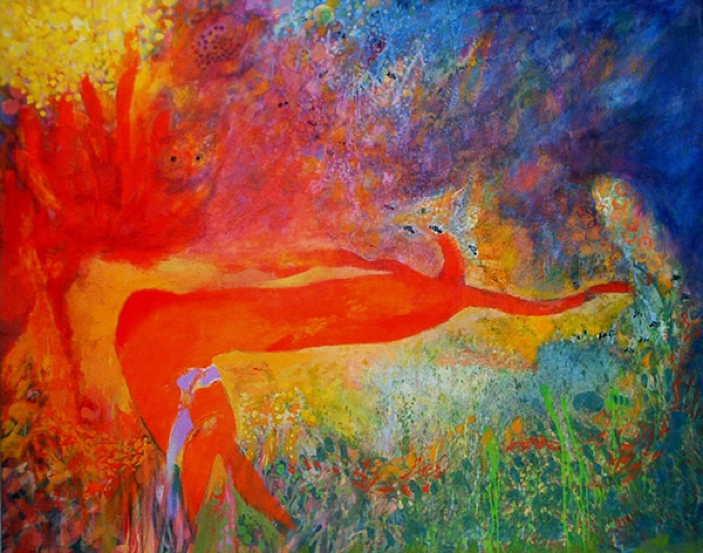A question of identity
Leon De Bliquy – “Ship of Fools” Exhibition
Recently, our school held an exhibition of Leon De Bliquy’s “Ship of Fools”. It is an exhibition of a number of beautiful and colourful paintings (and some lithographs), the last works he made before losing his sight. Leon came to the exhibition and was happy to answer any questions we had. At the end he told us that he wanted to thank his muse (his wife, who was there to support him) because if it wasn’t for her none of this would have been possible. This exhibition was first held in South Africa in 2012, “Gathering of Jesters”, which is Leon’s home country.
As an art student, I had the privilege to meet Leon twice because he came to one of our classes to speak about his work. In class he spoke to us about the meaning of the work, and what inspired him in the first place.
He started off by quoting Shakespeare: “A fool thinks himself to be wise, but a wise man knows himself to be a fool”. So how did he find such interest in this idea of being a ‘fool’ you might wonder. He told us the story of when he was insulted by someone who was reviewing his work, and in this very disheartening insult the person made sure to include the word ‘fool’ to describe him. He took interest in this, and started researching about fools and what it meant to be one.
The fool is an ambiguous and ambivalent character in art, literature and myth. In Shakespeare’s ‘King Lear’ the fool is the only one that can tell the truth openly, whereas the others flatter and lie. Hieronymous Bosch’s painting “Ship of Fools” (which inspired Leon De Bliquey) painted in the 15th century is a parallel visual satire that reflects his perception of the human condition while evoking the medieval tradition of getting rid of the unwanted, mad and crazy people by sending them away from the city in a boat. Furthermore, when you look up the word fool, you find a lot of information on jesters. Jesters were professional jokers or fools for entertainment in the medieval times. They are in a sense the best way to define a “fool” concretely and visually. They are visually very distinctive because they wear special, “funny” clothing and they might even look a little different.
This idea poses many questions about identity. What does it mean to be a fool? Is it necessarily bad to be one? Nowadays, it is predominantly used to describe someone who is crazy, someone who isn’t normal. But is this just a reflection of our fear of being different, of being unconventional and not living under the norms of society? What does it even mean to be normal? Are we fools for thinking this way? Aren’t those who aren’t afraid those who flourish the most in life?
Leon decided to paint a number of ‘fools’ and ironically turn this insult into an artistic investigation of self. His fools are all depicted as different jesters. Jesters with a certain name, and a distinctive identity. Each of the jesters tell a different story of self. He has named them according to what they “do”, such as the “Music Jester” who is playing a woodwind instrument and a guitar while tapping his feet to the beat. Or the “Flying Jester” who is flying towards the unknown. He has also given them short descriptions. “What makes the music fool? He is picking the guitar strings, tapping his fingers on the piano, he blows a tune to please the hearing ear, slowly stroking some hearts with love” and “Whither doth the flying jester fly? Somewhere and eventually to return, past the moon or into the blinding sun? To imagine wings, not to ask where this desire to fly begun.” They have each been given a specific destiny, which fulfils their identity. It’s ironic because he has created these ‘fools’, but he has made each one of them so important for what they are that we don’t focus on the fact that they are fools or jesters. In reality they would be shunned, because that is the ill-fated destiny that their external appearance has brought upon them. However, this doesn’t stop them from completely being what they are destined to be, wholesomely and mesmerizingly. The works’ dreaminess and surrealism can reflect a fool’s mind, and the world through a fool’s eyes. I think that this can teach us to always believe in what we want, even though it might make us seem crazy or weird. This expresses the idea that we all have a little foolishness within us.
His paintings are extremely colourful and have been painted with a dot like application, similar to the style of Monet. The colours, shapes and patterns give them a very dream-like sense, and they portray some surrealism. They are very pleasing and intriguing to the eye. When you first look at them, it is kind of hard to see exactly what is going on because there is so much to the painting. But when you take your time and look closely you can see all the details in the background and the mixing of colours that come together to produce a beautiful work of art. When I asked Leon if his imagination has changed in any way since he lost his sight he said that if anything his imagination is more inspired than before; that colours are brighter and his dreams are more vivid. He told us that it’s amazing what some colour and a paint brush can do, the way they work together and fill a blank paper with a story.
“Totem Dance”

"Flying Jester"

"The Music Jester"

// Anna